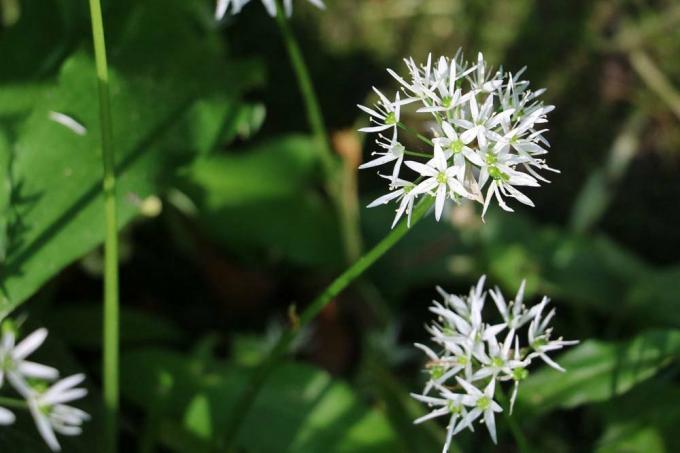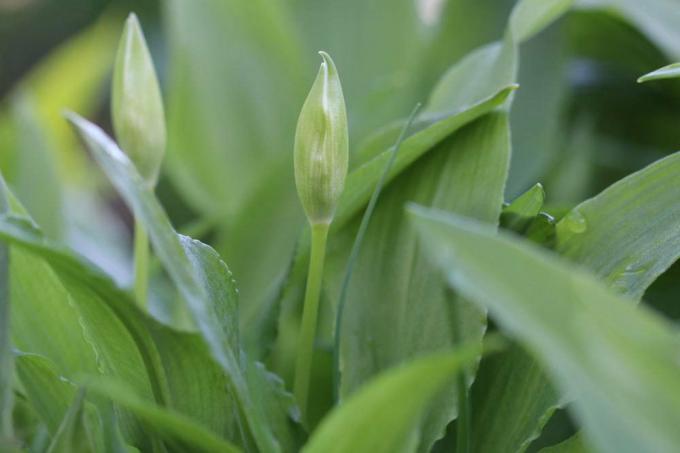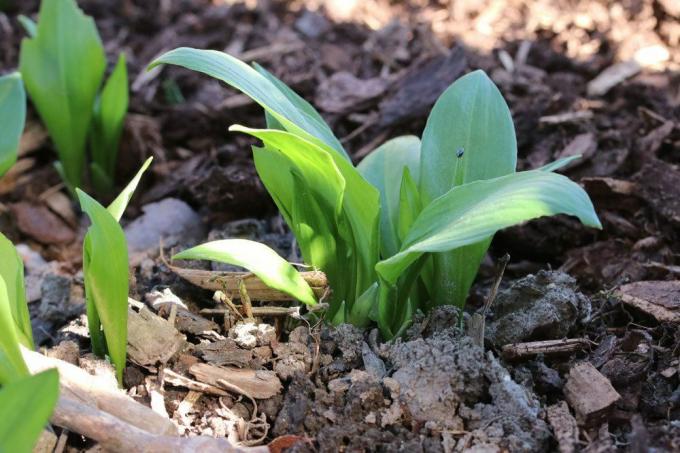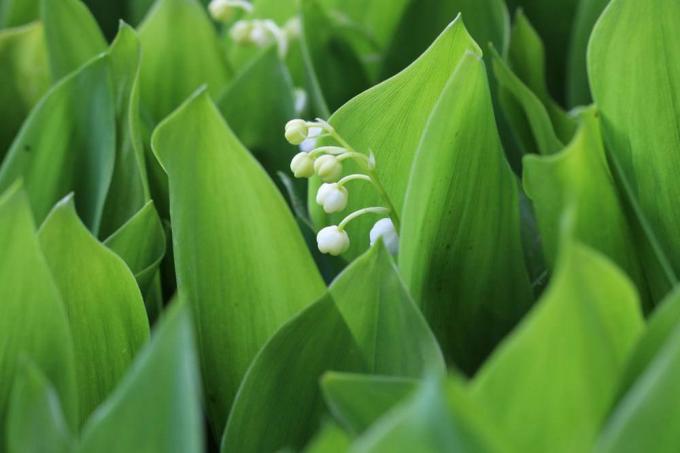
table of contents
- Likelihood of confusion
- Wild garlic
- Wild garlic leaf
- lily of the valley
- Lily of the valley leaf
- Autumn crocus
- leaves
The wild garlic harvest season begins in March and numerous enthusiasts set off every year to collect the forest garlic for their own use. Heard with its characteristic aroma Allium ursinum is one of the classics in the kitchen, but you have to watch out for hidden dangers when harvesting wild wild garlic. Lily of the valley and autumn crocus grow in close proximity and look very similar to wild garlic plants, but the differences are clear on closer inspection.
Likelihood of confusion
Caution: risk of confusion
Because the leaf shape is similar at first glance, it has often happened to people Instead of wild garlic, collect the poisonous lilies of the valley and autumn crocus and eat them poison. It is therefore important to know how the individual species differ so that none of these dangerous poisonous plants end up in the basket during harvest time. The plants are no longer really similar from flowering, but it takes at least until April before the first wild garlic flowers can be seen. Lilies of the valley bloom even later. That is why it is especially important in March to know the characteristics of each species.
- Leaf shape
- colour
- nature
- blossom
- growth
- odor
- Location

All of these elements help with identification and can be applied on the spot. It will be difficult to tell the leaves apart once they get into your collection bag. You are therefore on the safe side if you identify the plants before harvesting and only harvest the wild garlic plants that have been checked. This is the only way to completely rule out not having collected any poisonous leaves. It is fascinating to see that the three plants come from completely different families, but look very similar without the flower.
Note: Of course, this distinction is only necessary if you go to collect wild garlic in the forest. If you have grown Allium ursinum yourself, you cannot really confuse the plant, unless you have planted autumn crocus or lilies of the valley right next to it.
Wild garlic
Wild garlic in detail
Allium ursinum belongs to the leek family and is therefore related to garlic, onions and chives. The forest garlic is therefore just as popular in the kitchen as the other plants because it contains the same ingredients, only in a different concentration. One of the biggest and most important differences in wild garlic is the aroma. Of the three "doppelgangers", only the forest garlic has essential oils in the leaves, which provide the typical smell and unmistakably indicate the leek plant.
The location is as follows:
- Deciduous and mixed forests
- Riparian forests preferred
- moist, nutrient-rich soils, often loamy
- partially shaded
Wild garlic likes to grow in the dark and prefers soils that offer them enough space and nutrients so that they can form large accumulations. Depending on the location of the forest area, it can happen that the individual locations overlap and provide the poisonous plants with just as good conditions, which in turn can lead to confusion. From this point on, the determination of the leaves and the growth is added, as the site conditions alone are not sufficient. It even happens frequently that Convallaria majalis grows directly between the wild garlic plants.

Wild garlic leaf
The wild garlic leaf is made as follows:
- sprout earlier than the lily of the valley and autumn crocus
- in warmer regions (southern Germany) from late February to early March
- 1-3 leaves are formed, two of which are the most common
- between 2 - 5 cm wide and oval
- each leaf grows individually on a petiole with a length of 5 - 20 mm
- the stem grows either directly from the bulb or the flower stem
- parallel nerve
- The underside of the leaf is matt (very important)
- triangular, hollow handle
- Leaves are soft
- often look out of the snow
In addition to the smell, a decisive factor is the underside of the leaf, which can immediately tell which plant it is. Autumn croissants and lilies of the valley do not have a matt underside and are also much harder than the soft wild garlic leaves. Because of this, the leaves lose their aroma faster. The differences in growth are just as important, because with Allium ursinum the leaves grow on the stem first and do not enclose it. They spread from the flower stalk and hang down in an arch so that the tip almost touches the ground.

The flower, on the other hand, looks like this:
- Color white
- individual flowers, about 20, stand together in a sham umbel
- Scheindolde is round
- individual flower stalks can be up to 2 cm long
- Petals are 8-10 mm long, mostly pointed
- Flowering period: April - June
The three plants are particularly easy to distinguish on the basis of their flowers and you cannot confuse them if you were to collect during the flowering period. However, the intense aroma of the leaves suffers from the flowers and therefore the best harvest time falls in March, when the leaves are in their best growth phase. In general, it is advisable to only harvest the wild garlic when the individual stems have already been driven far enough out of the ground. This allows you to see whether the leaves are standing individually or together.
Note: Don't rely solely on the scent of the leaves here when collecting Allium ursinum. As the aromas soak into the skin, the scent sticks to you and can cause you to rub the leaves of a poisonous doppelganger and then smell them like the witch onion.
lily of the valley
Lily of the valley in detail
The lily of the valley is an asparagus plant that comes from the same order as the forest garlic, but not from the same family. For this reason, they look so similar, but on closer inspection they differ significantly. These differences start with the leaf, which is completely different from that of wild garlic. However, you can easily confuse the two as they look really alike, especially in the first few weeks after sprouting.

Lily of the valley leaf
The lily of the valley leaf in detail:
- sprout only from March
- often only to be seen when there is no more snow
- two leaves are always formed, less often three, whereby this is the exception
- Leaves sprout together on a stem
- then embrace the peduncle
- the flower stalk shoots from the middle between the leaves
- Length: 12-20 cm
- Width: 2.5 - 5 cm
- Leaves are rolled into the involucre sheet (bract)
- the bract turns brownish in the course of growth
- they are broad and lanceolate in shape
- The leaves are pointed and point upwards
- do not fall like wild garlic leaves
- There are also several lower leaves directly on the ground that surround the base
- have a glossy surface and underside
- have no flavor
The lily of the valley and the wild garlic have the highest chance of being confused, as the differences are quite subtle at first glance. But on closer inspection, they can no longer be confused, at the latest when you turn the pages over. This is particularly important because lilies of the valley often do not develop flowers when they are found in a wild garlic location. Since these are often shady, the lily of the valley focuses purely on the formation of the leaves, which makes it easy to confuse the two plants.
Convallaria majalis is more often found elsewhere:
- all forms of forests
- light forests preferred
- Pine, beech and oak forests are particularly popular
- sunny locations help with flower formation
The flower is characteristic because it gave the plant its name. The small, white flowers hang down in bells and are all on a long stem that grows between the two leaves. During the flowering period from May to June these present themselves in all their glory.

Tip: To avoid confusing the two plants, you can easily expose the soil around the lilies of the valley. They form rhizomes through which the roots grow close to the surface, which neither the wild garlic nor the autumn crocus do.
Autumn crocus
Herbstzeitlose in detail
The autumn crocus belongs to the timeless family in the lily genus and is rarely found with wild garlic. The preferred location for autumn crocus is namely moist meadows and forests. The edge of the forest is a typical area for Colchicum autumnale. Nevertheless, it can happen that autumn crocus occurs together with the forest garlic and here it is particularly important to distinguish the two plants. Autumn croissants are even more poisonous than lilies of the valley, and an amount of 50 grams is fatal to adults.
leaves
Therefore, do not confuse the leaves:
- Leaves do not sprout until May
- resemble wild garlic leaves in size and texture
- are longer, up to 40 cm
- are harder
- arise from a petiole, like the lilies of the valley
- envelop the seed capsule in the lower part
- quite a lot of leaves are formed that build on each other
- they encompass the stem
- Leaves are lighter colored in the lower part
- Glossy top and bottom

A special feature that can be dangerous is the flowering time of the autumn crocus. This does not begin until autumn and therefore you have to pay particular attention to whether the underside of the leaves is shiny and the leaves arise from a stem, otherwise it will be extremely dangerous.
